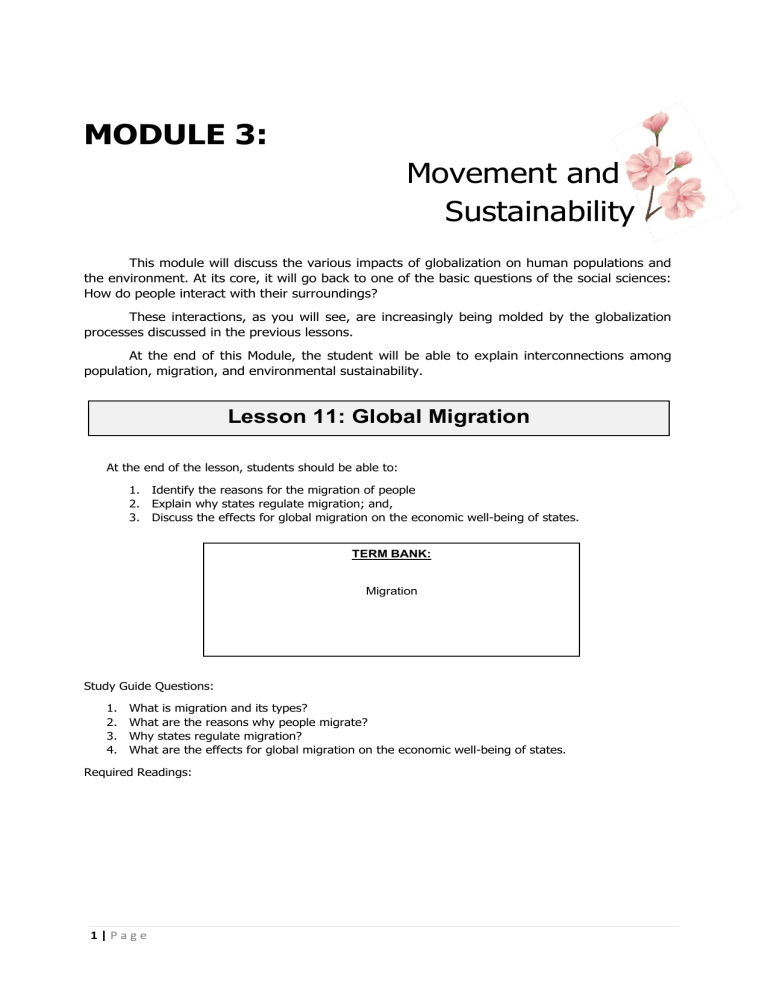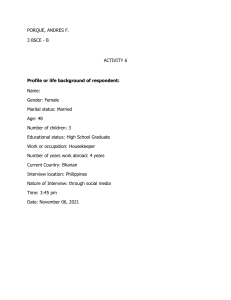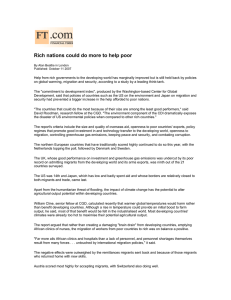
MODULE 3: Movement and Sustainability This module will discuss the various impacts of globalization on human populations and the environment. At its core, it will go back to one of the basic questions of the social sciences: How do people interact with their surroundings? These interactions, as you will see, are increasingly being molded by the globalization processes discussed in the previous lessons. At the end of this Module, the student will be able to explain interconnections among population, migration, and environmental sustainability. Lesson 11: Global Migration At the end of the lesson, students should be able to: 1. Identify the reasons for the migration of people 2. Explain why states regulate migration; and, 3. Discuss the effects for global migration on the economic well-being of states. TERM BANK: Migration Study Guide Questions: 1. 2. 3. 4. What is migration and its types? What are the reasons why people migrate? Why states regulate migration? What are the effects for global migration on the economic well-being of states. Required Readings: 1|Page LESSON 11: GLOBAL MIGRATION TWO TYPES OF MIGRATION 1. Internal Migration – refers to people moving from one are to another within one country 2. International Migration – people cross borders of one country to another. Five (5) types of International Migrants: a.) Immigrants – who move permanently to another country b.) workers who stay in a country for fixed period (at least 6 mos. In a year) c.) Illegal Immigrants d.) Migrants whose families have petitioned them to move to the destination country e.) Refugees – also known as asylum – seekers • 247 Million no. of people currently living outside the countries of their birth. 90% of the, moved for economic reasons while the remaining 10% were refugees and asylum-seekers. ▪ The top three regions of origin are Latin America (18% of global total), followed by Eastern Europe and Central Asia (16%), and the Middle East and North Africa (14%). On a per country basis, India, Mexico, and China are leading, with the Philippines, together with Afghanistan, only ranking 6th in the world. The top 10 country destinations of these migrants are mainly in the West and the Middle East, with the United States topping the list. • 50% of global migrants – moved from the developing countries to the developed zones of the world and contribute from 40% to 80% of their labor force • McKinsey Global Institute – first – generation immigrants constitute 13 percent of the population in Western Europe, 15% in North America, 48% in the GCC countries. 2|Page Percentage of Migrants in Cities – 92% in US, 95% in UK, 99% in Australia COUNTRY CONTRIBUTION % OF GDP U.S $ 2 trillion 11% U.K $390 billion 14% Germany $550 billion 17% Canada $ 320 billion 21% Australia $330 billion 25% The migrant influx has led to a debate in destination countries over the issue of whether migrants are assets or liabilities to national development. Anti-immigrant groups and nationalists argue that governments must control legal immigration and put a stop to illegal entry of foreigners. Most of these anti-immigrant groups are gaining influence through political leaders who share their belief. For example, President Donald Trump & UK Prime Minister Theresa May – reverse the existing pro – immigration and refugee sympathetic policies of their states. Most recently, Trump attempted to ban travel into the US of people from Majority-Muslim countries, even those with proper documentation. He also continues to speak about his election promise of building a wall between the US and Mexico. The wisdom of these government actions has been consistently belied by the data. A Harvard Business School survey in 2011, concluded that “likelihood and magnitude of adverse labor market effects for native from immigration are substantially weaker that often perceived.” The fiscal impact of immigration on social welfare was noted to be “very small.” Furthermore, the Organization for Economic Co – Operation and Development (OECD) report on 2013, shows that native- born citizens still receive higher support compared to immigrants. The massive inflow of refugees from Syria and Iraq has raised alarm bells once again, but has not proved to be as damaging as expected. The International Monetary Fund predicted that the flow of refugees feeling the war in Syria and Iraq would actually grow Europe’s GDP, albeit “modestly”. In Germany, the inflow of refugees from the Middle East has not affected social welfare programs, and had very little impact on wages and employment. In fact, they have brought much-needed labor to the economy. 3|Page Benefits and Detriments for the sending country 1. Remittances from abroad a. Ninety (90) percent of the value (over billions) generated by migrant workers return to home countries. In 2014, India held the highest recorded remittance (70 billion USD), followed by China (62 billion), the Philippines (28 billion USD), and Mexico (25 billion USD). b. Why remittances are good? i. These remittances make significant contributions to the development of small – and medium term industries that help generate jobs. ii. Remittances likewise change the economic and social standing of migrants, as shown by new or renovated homes and their relatives’ access to new consumer goods. The purchasing power of a migrant’s family doubles and makes it possible for children to start or continue their schooling. c. Why remittances are bad? i. The Asian Development Bank (ADB) observes that in countries like the Philippines, remittances “do not have a significant influence on other key items of consumption or investment such as spending on education and health care.” ii. Remittances, therefore, may help in lifting “households out of poverty…but not in rebalancing growth, especially in the long run.” 2. “Brain Drain” a. The global migration is “siphoning… qualified personnel, removing dynamic workers.” This process has often been referred to as “brain drain.” According to McKinsey Global Institute, countries in sub-Saharan Africa and Asia have lost 1/3 of their college graduates. 60% of those who moved to OECD destinations were college graduates, compared to just 9% of the overall population in the developed world have tertiary education, which is more than double the 23% of the overall Filipino population. The loss of professionals in certain key roles, such as doctors, has been detrimental to the migrants’ home countries. In 2006, some 15% of locally trained doctors from 21 sub-Saharan African countries had emigrated to the US or Canada; the losses were particularly steep in Liberia (where 43% of doctor’s eft), Ghana (30%) and Uganda (20%) 4|Page What is the take of the government with all of these? • The government are aware of the long-term handicap, but have no choice but to continue but to continue promoting migrant work as part of state policy because of the remittances’ impact on GDP. The Problem of Human Trafficking On top of the issue of brain drain, sending states must likewise protect migrant workers. The US Federal Bureau lists human trafficking as the 3rd largest criminal activity worldwide. In 2012, the International Labor Organization (ILO) identified 21 million men, women, and children as victims of “forced labor,” an appalling three out every 1,000 persons worldwide. 90% of victims (18.7 million) are exploited by private enterprises and entrepreneurs; 22% (4.5 million) are sexually abused; and 68% (14.2 million) work under compulsion in agricultural, manufacturing, infrastructure, and domestic activities. Human trafficking has been very profitable, earning syndicates, smugglers, and corrupts state officials’ profits of as high as 150 Billion USD a year in 2014. Governments, the private sector, and civil society groups have worked together to combat human trafficking, yet the results remain uneven. Integration 1. The final issues relate to how migrants interact with their new home countries. They may contribute significantly to a host’s nation GDP, but their access to housing, health care, and education is not easy. 2. Democratic states assimilate immigrants and their children by granting them citizenship and the rights that go with it. However, without solid support from their citizens, switching citizenship may just be a formality. Linguistic difficulties, customs from the “old country” and, of late, differing religions may create cleavages between migrants and citizens of receiving countries. 5|Page 3. Migrants unwittingly reinforce the tension by “keeping among themselves.” The first-time migrant’s anxiety coming into a new and often “strange” place mitigated by “local networks of fellow citizens” that serves as the migrant’s safety net from the dislocation of uprooting oneself. 6|Page



